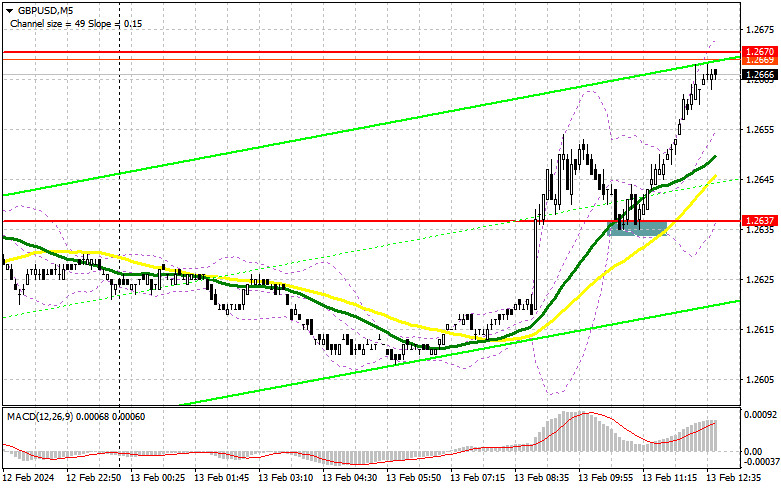
In my morning forecast, I paid attention to the 1.2637 level and planned to make decisions on entering the market from it. Let's look at the 5-minute chart and figure out what happened there. The breakout and the reverse test of 1.2637 from top to bottom led to a buy signal, which resulted in an increase in the pair by more than 35 points. In the afternoon, the technical picture was revised.
To open long positions on GBP/USD, it is required:
Strong data on the UK labor market, as well as maintaining steady wage growth – all this has led to a strengthening of the pound's position against the dollar, as it will obviously force the Bank of England to continue to act quite aggressively with regard to rates. Their decline in the spring of this year can clearly be forgotten. But we have important data ahead on the US consumer price index for January this year. If the price increase continues, most likely the pound will collapse, resuming its bearish trend paired with the US dollar.

I plan to act after the decline and the formation of a false breakdown in the area of 1.2637 – the support formed by the results of the first half of the day. This will give an excellent entry point into long positions in the expectation of another recovery of the pair to 1.2670. Breaking and consolidating above this range against the backdrop of weak US inflation will only strengthen demand for the pound, opening the way to 1.2703. The ultimate target will be 1.2735, where I plan to make a profit. In the scenario of the pair's decline and the absence of bullish activity at 1.2637 in the second half of the day, which can only happen in the case of continued US inflation growth, pressure on the pound will undoubtedly increase. In such a case, I will postpone purchases until testing 1.2606. Only a false breakout will confirm the correct entry point into the market. I plan to buy GBP/USD immediately on a rebound from the minimum of 1.2573 with the target of a correction by 30-35 points within the day.
To open short positions on GBP/USD, the following is required:
Sellers find it challenging to assert themselves in the current situation. Nevertheless, I prefer to open new short positions only on growth around the resistance of 1.2670. The formation of a false breakout there will confirm the presence of large players, leading to a decline to 1.2637 – the support formed by the results of today, where buyers have already shown themselves well once. Therefore, breaking and reverse testing from the bottom to the top of this range will hit bullish positions, leading to the triggering of stop orders and opening the way to 1.2606. The ultimate target will be the area around 1.2573, where profits will be fixed. In the case of GBP/USD growth and the absence of activity at 1.2670 in the second half of the day after weak US inflation data, the pair will break out of the sideways channel, and buyers will attempt to continue the upward correction. In such a case, I will postpone selling until a false breakout at the level of 1.2703. If there is no downward movement there, I will sell GBP/USD immediately on a rebound from 1.2735, but only expecting a pair correction down by 30-35 points within the day.
In the COT report (Commitment of Traders) as of February 6, there was an increase in both short and long positions. Despite traders now having a clear view of the future policy of the Bank of England, which intends to continue actively combating inflation, the pound is not in a hurry to demonstrate growth. Recent statements by British politicians indicate a soft wait-and-see position that can change at any moment – if, of course, the data allows. A lot of statistics on the labor market, wage growth, and inflation in the UK will be released soon, which can significantly change the balance of power in the market. But don't forget to add the wait-and-see position of the Federal Reserve to all this, so uncertainties are now more than before. The latest COT report states that long non-commercial positions increased by 6,437 to the level of 83,936, while short non-commercial positions jumped by 6,115 to the level of 49,461. As a result, the spread between long and short positions decreased by 2,374.Indicator signals:
Moving averages:
Trading is conducted above the 30 and 50-day moving averages, indicating further pound growth.
Note: The period and prices of moving averages are determined by the author on the hourly chart H1 and differ from the general definition of classic daily moving averages on the daily chart D1.
Bollinger Bands:
In case of a decline, the lower boundary of the indicator at 1.2600 will act as support.
Description of indicators:
Moving Average (MA) is a trend indicator, determining the current trend by smoothing volatility and noise. Period 50. Marked on the chart in yellow.Moving Average (MA) is a trend indicator, determining the current trend by smoothing volatility and noise. Period 30. Marked on the chart in green.MACD indicator (Moving Average Convergence/Divergence) Fast EMA period 12. Slow EMA period 26. SMA period 9.Bollinger Bands - volatility indicator consisting of an SMA and two standard deviations from it. Period 20.Non-commercial traders - speculators, such as individual traders, hedge funds, and large institutions, using the futures market for speculative purposes and meeting certain requirements.Long non-commercial positions represent the total long open position of non-commercial traders.Short non-commercial positions represent the total short open position of non-commercial traders.The total non-commercial net position is the difference between non-commercial long and short positions.